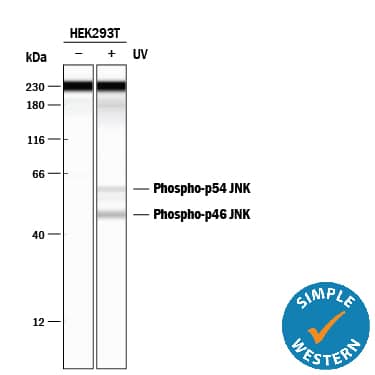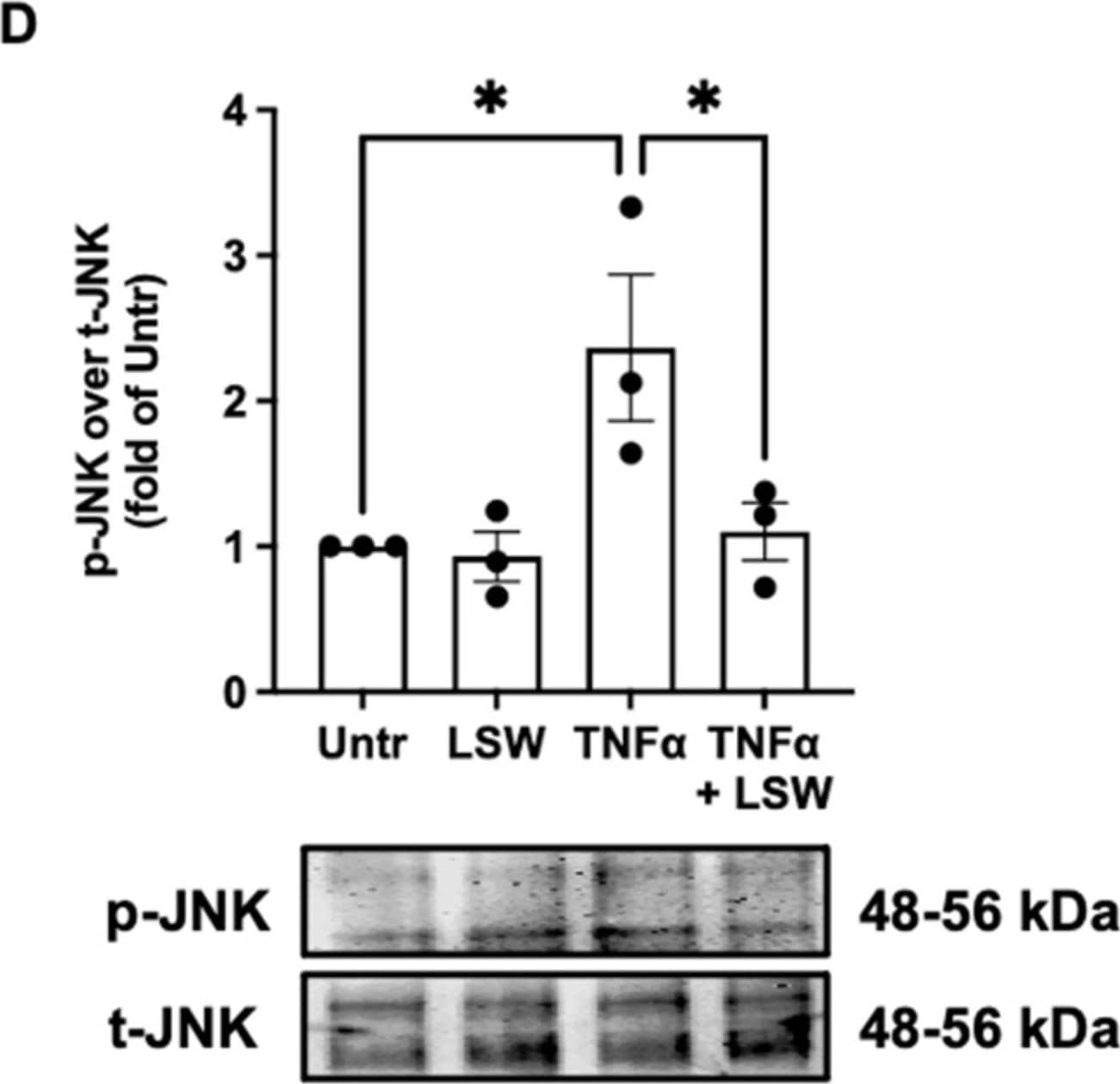Human/Mouse/Rat Phospho-JNK (T183/Y185) Antibody
R&D Systems, part of Bio-Techne | Catalog # MAB1205

Key Product Details
Validated by
Species Reactivity
Validated:
Cited:
Applications
Validated:
Cited:
Label
Antibody Source
Product Specifications
Immunogen
Specificity
Clonality
Host
Isotype
Scientific Data Images for Human/Mouse/Rat Phospho-JNK (T183/Y185) Antibody
Detection of Human and Mouse Phospho-JNK (T183/Y185) by Western Blot.
Western blot shows lysates of HeLa human cervical epithelial carcinoma cell line and 293T human embryonic kidney cell line untreated (-) or treated (+) with 20 mJ/cm2ultraviolet light (UV) followed by a 30 minute recovery. PVDF membrane was probed with 1 µg/ml of Rabbit Anti-Human/Mouse/Rat Phospho-JNK (T183/Y185) Monoclonal Antibody (Catalog # MAB1205), followed by HRP-conjugated Anti-Rabbit IgG Secondary Antibody (Catalog # HAF008). Specific bands were detected for Phospho-JNK (T183/Y185) at approximately 46 and 54 kDa (as indicated). This experiment was conducted under reducing conditions and using Immunoblot Buffer Group 1.Phospho-JNK (T183/Y185) in HEK293 Human Cell Line.
JNK phosphorylated at T183/Y185 was detected in immersion fixed HEK293 human embryonic kidney cell line untreated (lower panel) or treated with UV radiation (upper panel) using Rabbit Anti-Human/Mouse/Rat Phospho-JNK (T183/Y185) Monoclonal Antibody (Catalog # MAB1205) at 25 µg/ml for 3 hours at room temperature. Cells were stained using the NorthernLights™ 557-conjugated Anti-Rabbit IgG Secondary Antibody (red; Catalog # NL004) and counterstained with DAPI. Filamentous actin was stained with fluorescein-conjugated phalloidin (green). Specific staining was localized to nuclei. View our protocol for Fluorescent ICC Staining of Cells on Coverslips.Detection of Human Phospho-JNK (T183/Y185) by Simple WesternTM.
Simple Western lane view shows lysates of HEK293T human embryonic kidney cell line untreated (-) or treated (+) with 20 J/m2ultraviolet light (UV) followed by a 30 minute recovery, loaded at 0.2 mg/mL. A specific band was detected for Phospho-JNK (T183/Y185) at approximately 46 and 56 kDa (as indicated) using 20 μg/ml of Rabbit Anti-Human/Mouse/Rat Phospho-JNK (T183/Y185) Monoclonal Antibody (Catalog # MAB1205). This experiment was conducted under reducing conditions and using the 12-230 kDa separation system. Non-specific interaction with the 230 kDa Simple Western standard may be seen with this antibody.Applications for Human/Mouse/Rat Phospho-JNK (T183/Y185) Antibody
Immunocytochemistry
Sample: Immersion fixed HEK293 human embryonic kidney cell line treated with UV radiation
Simple Western
Sample: HEK293T human embryonic kidney cell line treated with ultraviolet light (UV)
Western Blot
Sample: HeLa human cervical epithelial carcinoma cell line and 293T human embryonic kidney cell line treated with ultraviolet light (UV)
Reviewed Applications
Read 3 reviews rated 4.7 using MAB1205 in the following applications:
Formulation, Preparation, and Storage
Purification
Reconstitution
Formulation
Shipping
Stability & Storage
- 12 months from date of receipt, -20 to -70 °C as supplied.
- 1 month, 2 to 8 °C under sterile conditions after reconstitution.
- 6 months, -20 to -70 °C under sterile conditions after reconstitution.
Background: JNK
The c-Jun N-terminal Kinases (JNKs) are part of the MAPK (mitogen-activated protein kinase) system that transmits signals from the extracellular milieu to both the cytoplasm and nucleus of the cell. Following perturbation at the cell membrane, MEKKs/MAP3Ks are initially activated, followed by their activation of MKKs/MAP2Ks, and MKKs activation of MAPKs/MAP(1)Ks. There are three classes of MAPKs: ERKs, p38 Kinases and JNKs. JNKs are 45-55 kDa protein products of three genes which, through alternative splicing, generate up to 10 possible isoforms. The phosphorylation targets for MAPKs vary, but include p53, c-MYC, ATF2 and c-Jun, the latter molecule representing the namesake for the enzyme group. The three human JNKs share approximately 80% aa sequence identity. JNKs from human, mouse and rat all contain a conserved Met-Met-Thr(183)-Pro-Tyr(185)-Val-Val motif that undergoes dual phosphorylation by MMK4 and MMK7 to activate the different JNKs. Activated by environmental stresses and inflammatory cytokines, JNKs translocate to the nucleus where they regulate the activity of several transcription factors; including the c-Jun component of AP-1 and ATF-2.
Long Name
Alternate Names
Additional JNK Products
Product Documents for Human/Mouse/Rat Phospho-JNK (T183/Y185) Antibody
Product Specific Notices for Human/Mouse/Rat Phospho-JNK (T183/Y185) Antibody
For research use only




